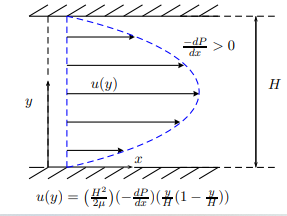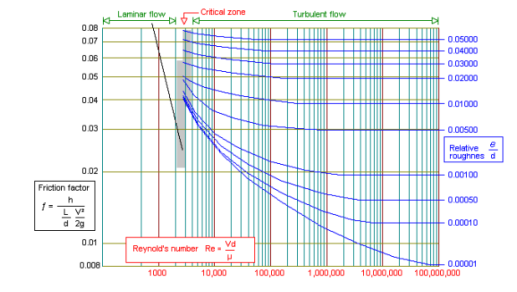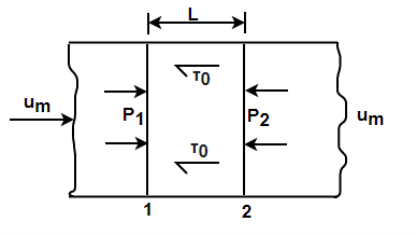Unit - 5
Laminar Flow
Flow through pipes, valves, fittings and measuring devices are dealt under this category. The conduits are generally circular, but there may be changes along the flow direction. As the wall shear is an important force, Reynolds number is the most important parameter. The pressure drop along the flow is more often the required parameters to be evaluated. Compressibility effect is negligible at low Mach number (M<0.3).
From dimensional analysis the pressure drop can be established as:

The geometric scale is given by the ratio scale=Lm/Lp
These requires

Reynolds number similarity leads to the condition for velocity ratio as:


If the fluid used for model and prototype is the same, then the


As λ is than one, the velocity to be used with the model has to be higher compare to the prototype otherwise a different fluid with higher viscosity should be chosen to satisfy the requirements.
The pressure drop in the prototype is calculated as in equation given below:
From equality of,

As  is measured using the model, the pressure drop in the prototype can be predicted.
is measured using the model, the pressure drop in the prototype can be predicted.
Key Takeaways:

Is the important formula.
Some of the fundamental solutions for fully developed viscous flow are shown next. The flow can be pressure or viscosity driven, or a combination of both. We consider a fluid, with viscosity µ and density ρ. (Note: W is the depth into the page.)
5.2.1. PLANE Wall-Driven Flow (Couette Flow):
Parallel flow: u(y) = u(y)ˆx, flow between parallel plates at y = 0 and y = H, wall-driven, and resisted by fluid viscosity
Umax = max(Utop, Ubottom)
Umin = min(Utop, Ubottom)
Uavg = 0.5 ∗ (Utop + Ubottom)
Q′ = Q/W
Q′ = (Utop − Ubottom)


5.2.2. PLANE Pressure-Driven Flow (Poiseuille Flow) (Stationary walls):
Parallel flow: u(y) = u(y)ˆx, flow between parallel plates at y = 0 and y = H, pressure driven.
5



(Tw on either wall in the x direction)

Turbulent flow occurs when the Reynolds number exceeds 4000.

Eddy currents are present within the flow and the ratio of the internal roughness of the pipe to the internal diameter of the pipe needs to be considered to be able to determine the friction factor. In large diameter pipes the overall effect of the eddy currents is less significant. In small diameter pipes the internal roughness can have a major influence on the friction factor. The ërelative roughness of the pipe and the Reynolds number can be used to plot the friction factor on a friction factor chart. The friction factor can be used with the Darcy-Weisbach formula to calculate the frictional resistance in the pipe. Between the Laminar and Turbulent flow conditions (Re 2300 to Re 4000) the flow condition is known as critical. The flow is neither wholly laminar nor wholly turbulent. It may be considered as a combination of the two flow conditions. The friction factor for turbulent flow can be calculated from the Colebrook-White equation:

Turbulence is caused by excessive kinetic energy in parts of a fluid flow, which overcomes the damping effect of the fluid's viscosity. The mixing action of the turbulent flow enhances the temperature averaging effect in addition to the transfer of energy from the hot water to the surrounding fluid. When a hot object is cooled, the mixing action of turbulent flows in the fluid surrounding the object plays an important role in cooling it.
Key Takeaways:

5For turbulent flow.
In the design of piping systems, the choice falls between the selection of diameter and the pressure drop. The selection of a larger diameter leads to higher initial cost. But the pressure drop is lower in such a case which leads to lower operating cost. So, in the process of design of piping systems it becomes necessary to investigate the pressure drop for various diameters of pipe for a given flow rate. Another factor which affects the pressure drop is the pipe roughness. It is easily seen that the pressure drop will depend directly upon the length and inversely upon the diameter. The velocity will also be a factor and in this case the pressure drop will depend in the square of the velocity (refer Bernoulli equation).

Hence, we can say that
The proportionality constant is found to depend on other factors. In the process of such determination Darcy defined or friction factor f as

This quantity is dimensionless which may be checked. Extensive investigations have been made to determine the factors influencing the friction factor. It is established that in laminar flow f depends only on the Reynolds number and it is given by

In the turbulent region the friction factor is found to depend on Reynolds number for smooth pipes and both on Reynolds number and roughness for rough pipes. Some empirical equations are given in section and also under discussions on turbulent flow. The value of friction factor with Reynolds number with roughness as parameter is available in Moody diagram. Using the definition of Darcy friction factor and conditions of equilibrium, expression for pressure drop in pipes is derived in this section. Consider an elemental length L in the pipe. The pressures at sections 1 and 2 are P1 and P2.

The other force involved on the element is the wall shear t0.
Net pressure force in the element is (P1 –P2)
Net shear force in the element is t0 PDL
Force balance for equilibrium yields

From the definition friction factor


Substituting and letting (P1 –P2) to be ΔP.

This reduces to

This equation known as Darcy-Weisbach equation and is generally applicable in most of the pipe flow problems.
The friction factor or Moody chart is the plot of the relative roughness (e/D) of a pipe against the Reynold's number. The blue lines plot the friction factor for flow in the wholly turbulent region of the chart, while the straight black line plots the friction factor for flow in the wholly laminar region of the chart.
The Moody chart or Moody diagram is a graph in non-dimensional form that relates the Darcy-Weisbach friction factor, Reynolds number and relative roughness for fully developed flow in a circular pipe. It can be used for working out pressure drop or flow rate down such a pipe.

Pressure drop can then be evaluated as:
 or directly from
or directly from 
Where the density of the fluid is, is the average velocity in the pipe, is the friction factor from the Moody chart, is the length of the pipe and is the pipe diameter.
The Moody chart can be divided into two regimes of flow: laminar and turbulent. For the laminar flow regime, the Darcy–Weisbach friction factor was determined analytically by Poiseuille and is used. In this regime roughness has no discernible effect. For the turbulent flow regime, the relationship between the friction factor and the Reynolds number is more complex and is governed by the Colebrook equation which is implicit in

In 1944, Lewis Ferry Moody plotted the Darcy–Weisbach friction factor into what is now known as the Moody chart.
Key Takeaways:
The Moody chart can be divided into two regimes of flow: laminar and turbulent. For the laminar flow regime, the Darcy–Weisbach friction factor was determined analytically by Poiseuille and it is used.
References:
- Frank M. White, Fluid mechanics, Tata McGraw Hills.
- Som and Biswas, Fluid mechanics and machinery.
- Various presentations and pdf from different websites.